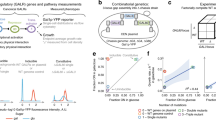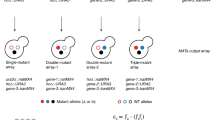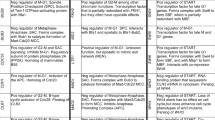Abstract
Dosage suppression is a genetic interaction in which overproduction of one gene rescues a mutant phenotype of another gene. Although dosage suppression is known to map functional connections among genes, the extent to which it might illuminate global cellular functions is unclear. Here we analyze a network of interactions linking dosage suppressors to 437 essential genes in yeast. For 424 genes, we curated interactions from the literature. Analyses revealed that many dosage suppression interactions occur between functionally related genes and that the majority do not overlap with other types of genetic or physical interactions. To confirm the generality of these network properties, we experimentally identified dosage suppressors for 29 genes from pooled populations of temperature-sensitive mutant cells transformed with a high-copy molecular-barcoded open reading frame library, MoBY-ORF 2.0. We classified 87% of the 1,640 total interactions into four general types of suppression mechanisms, which provided insight into their relative frequencies. This work suggests that integrating the results of dosage suppression studies with other interaction networks could generate insights into the functional wiring diagram of a cell.
This is a preview of subscription content, access via your institution
Access options
Subscribe to this journal
Receive 12 print issues and online access
$209.00 per year
only $17.42 per issue
Buy this article
- Purchase on Springer Link
- Instant access to full article PDF
Prices may be subject to local taxes which are calculated during checkout





Similar content being viewed by others
Accession codes
References
Vavouri, T., Semple, J.I., Garcia-Verdugo, R. & Lehner, B. Intrinsic protein disorder and interaction promiscuity are widely associated with dosage sensitivity. Cell 138, 198–208 (2009).
Sopko, R. et al. Mapping pathways and phenotypes by systematic gene overexpression. Mol. Cell 21, 319–330 (2006).
Santarius, T., Shipley, J., Brewer, D., Stratton, M.R. & Cooper, C.S. A census of amplified and overexpressed human cancer genes. Nat. Rev. Cancer 10, 59–64 (2010).
Jones, G.M. et al. A systematic library for comprehensive overexpression screens in Saccharomyces cerevisiae . Nat. Methods 5, 239–241 (2008).
Moriya, H., Shimizu-Yoshida, Y. & Kitano, H. In vivo robustness analysis of cell division cycle genes in Saccharomyces cerevisiae . PLoS Genet. 2, e111 (2006).
Kaizu, K., Moriya, H. & Kitano, H. Fragilities caused by dosage imbalance in regulation of the budding yeast cell cycle. PLoS Genet. 6, e1000919 (2010).
Boone, C., Bussey, H. & Andrews, B.J. Exploring genetic interactions and networks with yeast. Nat. Rev. Genet. 8, 437–449 (2007).
Rine, J. Gene overexpression in studies of Saccharomyces cerevisiae . Methods Enzymol. 194, 239–251 (1991).
Prelich, G. Suppression mechanisms: themes from variations. Trends Genet. 15, 261–266 (1999).
Dixon, S.J., Costanzo, M., Baryshnikova, A., Andrews, B. & Boone, C. Systematic mapping of genetic interaction networks. Annu. Rev. Genet. 43, 601–625 (2009).
Costanzo, M. et al. The genetic landscape of a cell. Science 327, 425–431 (2010).
Baryshnikova, A. et al. Quantitative analysis of fitness and genetic interactions in yeast on a genome scale. Nat. Methods 7, 1017–1024 (2010).
Gavin, A.C. et al. Functional organization of the yeast proteome by systematic analysis of protein complexes. Nature 415, 141–147 (2002).
Krogan, N.J. et al. Global landscape of protein complexes in the yeast Saccharomyces cerevisiae . Nature 440, 637–643 (2006).
Yu, H. et al. High-quality binary protein interaction map of the yeast interactome network. Science 322, 104–110 (2008).
Tarassov, K. et al. An in vivo map of the yeast protein interactome. Science 320, 1465–1470 (2008).
Zhu, J. et al. Integrating large-scale functional genomic data to dissect the complexity of yeast regulatory networks. Nat. Genet. 40, 854–861 (2008).
Bender, A. & Pringle, J.R. Multicopy suppression of the cdc24 budding defect in yeast by CDC42 and three newly identified genes including the ras-related gene RSR1. Proc. Natl. Acad. Sci. USA 86, 9976–9980 (1989).
Shimada, Y., Wiget, P., Gulli, M.P., Bi, E. & Peter, M. The nucleotide exchange factor Cdc24p may be regulated by auto-inhibition. EMBO J. 23, 1051–1062 (2004).
Shannon, P. et al. Cytoscape: a software environment for integrated models of biomolecular interaction networks. Genome Res. 13, 2498–2504 (2003).
van Dongen, S. A Cluster Algorithm for Graphs (National Research Institute for Mathematics and Computer Science in The Netherlands, Amsterdam, 2002).
Myers, C.L., Barrett, D.R., Hibbs, M.A., Huttenhower, C. & Troyanskaya, O.G. Finding function: evaluation methods for functional genomic data. BMC Genomics 7, 187 (2006).
Ma, H., Kunes, S., Schatz, P.J. & Botstein, D. Plasmid construction by homologous recombination in yeast. Gene 58, 201–216 (1987).
Ho, C.H. et al. A molecular barcoded yeast ORF library enables mode-of-action analysis of bioactive compounds. Nat. Biotechnol. 27, 369–377 (2009).
De Wulf, P., McAinsh, A.D. & Sorger, P.K. Hierarchical assembly of the budding yeast kinetochore from multiple subcomplexes. Genes Dev. 17, 2902–2921 (2003).
Pagliuca, C., Draviam, V.M., Marco, E., Sorger, P.K. & De Wulf, P. Roles for the conserved spc105p/kre28p complex in kinetochore-microtubule binding and the spindle assembly checkpoint. PLoS ONE 4, e7640 (2009).
Pramila, T., Wu, W., Miles, S., Noble, W.S. & Breeden, L.L. The Forkhead transcription factor Hcm1 regulates chromosome segregation genes and fills the S-phase gap in the transcriptional circuitry of the cell cycle. Genes Dev. 20, 2266–2278 (2006).
Balciunas, D. & Ronne, H. Yeast genes GIS1–4: multicopy suppressors of the Gal- phenotype of snf1 mig1 srb8/10/11 cells. Mol. Gen. Genet. 262, 589–599 (1999).
Li, J.M., Li, Y. & Elledge, S.J. Genetic analysis of the kinetochore DASH complex reveals an antagonistic relationship with the ras/protein kinase A pathway and a novel subunit required for Ask1 association. Mol. Cell. Biol. 25, 767–778 (2005).
Tanaka, K. & Hirota, T. Chromosome segregation machinery and cancer. Cancer Sci. 100, 1158–1165 (2009).
Toda, T. et al. Cloning and characterization of BCY1, a locus encoding a regulatory subunit of the cyclic AMP-dependent protein kinase in Saccharomyces cerevisiae . Mol. Cell. Biol. 7, 1371–1377 (1987).
Klein, H.L. Spontaneous chromosome loss in Saccharomyces cerevisiae is suppressed by DNA damage checkpoint functions. Genetics 159, 1501–1509 (2001).
Hodgkin, J. Genetic suppression. WormBook 27, 1–13 (2005).
Reed, S.I., Hadwiger, J.A., Richardson, H.E. & Wittenberg, C. Analysis of the Cdc28 protein kinase complex by dosage suppression. J. Cell Sci. Suppl. 12, 29–37 (1989).
Wittenberg, C., Sugimoto, K. & Reed, S.I. G1-specific cyclins of S. cerevisiae: cell cycle periodicity, regulation by mating pheromone, and association with the p34CDC28 protein kinase. Cell 62, 225–237 (1990).
Aalto, M.K., Ronne, H. & Keranen, S. Yeast syntaxins Sso1p and Sso2p belong to a family of related membrane proteins that function in vesicular transport. EMBO J. 12, 4095–4104 (1993).
Watts, F.Z., Shiels, G. & Orr, E. The yeast MYO1 gene encoding a myosin-like protein required for cell division. EMBO J. 6, 3499–3505 (1987).
Rodriguez-Quinones, J.F. et al. Global mRNA expression analysis in myosin II deficient strains of Saccharomyces cerevisiae reveals an impairment of cell integrity functions. BMC Genomics 9, 34 (2008).
Mani, R., St. Onge, R.P., Hartman, J.L. IV, Giaever, G. & Roth, F.P. Defining genetic interaction. Proc. Natl. Acad. Sci. USA 105, 3461–3466 (2008).
St. Onge, R.P. et al. Systematic pathway analysis using high-resolution fitness profiling of combinatorial gene deletions. Nat. Genet. 39, 199–206 (2007).
Gasch, A.P. et al. Genomic expression programs in the response of yeast cells to environmental changes. Mol. Biol. Cell 11, 4241–4257 (2000).
Gordon, C.L. & King, J. Genetic properties of temperature-sensitive folding mutants of the coat protein of phage P22. Genetics 136, 427–438 (1994).
Warner, J.R. & McIntosh, K.B. How common are extraribosomal functions of ribosomal proteins? Mol. Cell 34, 3–11 (2009).
Haarer, B., Viggiano, S., Hibbs, M.A., Troyanskaya, O.G. & Amberg, D.C. Modeling complex genetic interactions in a simple eukaryotic genome: actin displays a rich spectrum of complex haploinsufficiencies. Genes Dev. 21, 148–159 (2007).
Komili, S., Farny, N.G., Roth, F.P. & Silver, P.A. Functional specificity among ribosomal proteins regulates gene expression. Cell 131, 557–571 (2007).
Ben-Aroya, S. et al. Toward a comprehensive temperature-sensitive mutant repository of the essential genes of Saccharomyces cerevisiae . Mol. Cell 30, 248–258 (2008).
Li, Z. et al. Systematic exploration of essential yeast gene function with temperature-sensitive mutants. Nat. Biotechnol. 29, 361–367 (2011).
Maere, S., Heymans, K. & Kuiper, M. BiNGO: a Cytoscape plugin to assess overrepresentation of gene ontology categories in biological networks. Bioinformatics 21, 3448–3449 (2005).
Butcher, R.A. & Schreiber, S.L. A microarray-based protocol for monitoring the growth of yeast overexpression strains. Nat. Protoc. 1, 569–576 (2006).
Pierce, S.E. et al. A unique and universal molecular barcode array. Nat. Methods 3, 601–603 (2006).
Lea, D.E. & Coulson, C.A. The distribution of the numbers of mutants in bacterial populations. J. Genet. 49, 264–285 (1949).
Acknowledgements
We thank S. Dixon for critical comments on the manuscript, M. Gebbia for microarray technical support, and C. Myers and J. Bellay for advice and data analysis support. L.M. was supported by a Canadian Institutes of Health Research (CIHR) doctoral research award. A.M.S. was supported by a University of Toronto open fellowship. J.S.C. and M.A.B. were supported by the Intramural Research Program of the US National Cancer Institute, US National Institutes of Health. G.G. was supported by the Canadian Cancer Society and the CIHR (research agreements 020380 and MOP-81340, respectively). C.N. was supported by the CIHR (MOP-84305). C.B. and B.A. were supported by Genome Canada through the Ontario Genomics Institute (2004-OGI-3-01). C.B. was supported by the CIHR (MOP-57830) and the Natural Sciences and Engineering Research Council of Canada (RGPIN 204899-06).
Author information
Authors and Affiliations
Contributions
L.M. was involved in MoBY-ORF construction, carried out experimental analysis and wrote the manuscript; C.H.H. was involved in MoBY-ORF construction, carried out experimental analysis and wrote the manuscript; S.L.B. was involved in MoBY-ORF construction and wrote the manuscript; W.J. and A.B. carried out computational analysis and wrote the manuscript; S.B. was involved in temperature-sensitive strain generation and carried out experimental analysis; A.M.S. and L.E.H. were involved in microarray data analysis; J.S.C. carried out the chromosome loss assays; E.K. and K.A. carried out experimental analysis and edited the manuscript; A.K. carried out experimental analysis; Z.L. was involved in temperature-sensitive strain generation; M.C. wrote the manuscript; M.A.B. edited the manuscript; G.G. and C.N. provided microarray data analysis and edited the manuscript; B.A. wrote the manuscript; C.B. conceived and planned the construction of the MoBY-ORF 2.0 library and wrote the manuscript.
Corresponding authors
Ethics declarations
Competing interests
The authors declare no competing financial interests.
Supplementary information
Supplementary Text and Figures
Supplementary Figures 1–5 (PDF 694 kb)
Supplementary Table 1
Dosage suppression interactions curated in the Saccharomyces Genome Database. (XLS 410 kb)
Supplementary Table 2
Dosage suppression interactions identified in this study using the MoBY-ORF 2.0 library. (XLS 122 kb)
Supplementary Table 3
Gene pairs from this study tested for reciprocal suppression interactions. (XLS 20 kb)
Supplementary Table 4
Gene pairs annotated in the Saccharomyces Genome Database that show reciprocal suppression interactions. (XLS 27 kb)
Supplementary Table 5
Significant enrichment of yeast two-hybrid interactions in the dosage suppression interaction network. (XLS 12 kb)
Supplementary Table 6
Restriction digest fragments of MoBY-ORF 2.0 plasmids. (XLS 574 kb)
Supplementary Table 7
Yeast strains used in this study. (XLS 338 kb)
Supplementary Table 8
MoBY-ORF 2.0 plasmids used in this study. (XLS 38 kb)
Rights and permissions
About this article
Cite this article
Magtanong, L., Ho, C., Barker, S. et al. Dosage suppression genetic interaction networks enhance functional wiring diagrams of the cell. Nat Biotechnol 29, 505–511 (2011). https://doi.org/10.1038/nbt.1855
Received:
Accepted:
Published:
Issue Date:
DOI: https://doi.org/10.1038/nbt.1855
This article is cited by
-
Evidence that conserved essential genes are enriched for pro-longevity factors
GeroScience (2022)
-
Dosage sensitivity of JDPs, a valuable tool for understanding their function: a case study on Caj1 overexpression-mediated filamentous growth in budding yeast
Current Genetics (2021)
-
High-throughput synthetic rescue for exhaustive characterization of suppressor mutations in human genes
Cellular and Molecular Life Sciences (2020)
-
Yeast genetic interaction screens in the age of CRISPR/Cas
Current Genetics (2019)
-
Chemical genomic guided engineering of gamma-valerolactone tolerant yeast
Microbial Cell Factories (2018)



